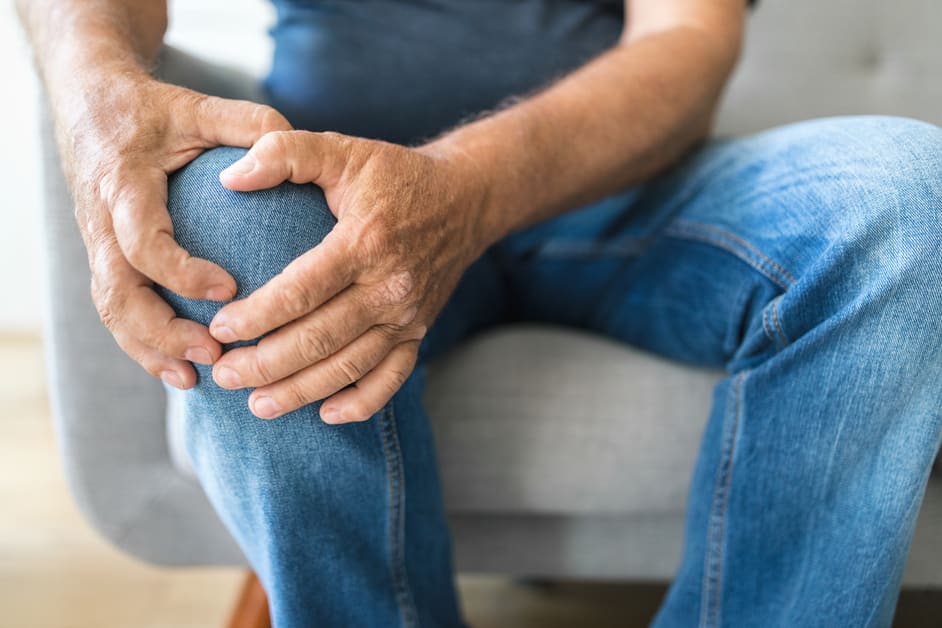Introduction
Knee injuries, like sprains and strains, can be really painful. This happens when the ligaments or tendons around your knee joint get stretched too far or torn. It is common in athletes and people who do physical activities such as running and jumping.
Good news! The pain from a sprain or strain can be relieved without medications. Here’s how to ease knee pain naturally:
- Home remedies
- Lifestyle adjustments
- Practical tips
Follow these natural strategies to reduce your symptoms.
Causes of Knee Pain
Knee pain? It could be from many reasons! Sprained ligament, inflamed joint, injury, age, overuse, or medical conditions can all lead to pain. Discovering what the cause is, helps find the best solution.
In this section, we’ll look at different causes of knee pain and how to help it naturally:
Sprain
A sprain is when a ligament, which joins two bones, is stretched or torn. This can cause pain, swelling, and inflammation in the knee joint. Sprains happen due to an accident with a twist or turn to the knee, or when too much weight is put on it. Mild sprains can be treated with rest and cold. Severe sprains may need a brace to heal.
Symptoms of a sprain differ depending on the injury. They can be:
- Pain when bearing weight;
- Difficulty bending and straightening the leg;
- Swelling and bruising;
- Tenderness;
- Limited motion;
- Instability;
- Deformity.
Sprain injuries must be treated quickly to avoid further damage. Rest, self-care, physical therapy, and massage are natural treatments for healing a sprained knee. However, it’s best to see an orthopedic specialist for optimal results.
Strain
A strain is when you pull or stretch a muscle or tendon too far. This happens when muscles are overused and can’t do what you want. Knee pain from a strain can be mild or moderate.
Causes of strains can include:
- Too many repetitions
- Heavy lifting
- Playing sports without warm up/cool down
If you have knee pain from a strain, rest your knee and avoid activities that cause strain. Ice and compression can help reduce inflammation and swelling. Ibuprofen or other NSAIDs may be prescribed. Stretching can help relieve knee pain and strengthen muscles to prevent future injuries.
Treatment Options
Knee pain from a sprain or strain can be mild to severe. Yet, there are natural ways to ease the pain. Treatment options for knee pain depend on the injury’s severity. Non-invasive remedies provide relief. RICE therapy is one of them. Massage and stretching are other specific techniques which help.
This section covers the various treatment options for easing knee pain from a sprain or strain:
- RICE therapy
- Massage
- Stretching
Rest
After a sprain or strain, rest is essential for at least 48 hours. Ice packs can be placed on the affected area in 15-20 minute intervals and ibuprofen (Advil) can be taken as directed. Avoid overexertion! No running, jumping, or heavy lifting. Assistive devices, like crutches or a cane, should be used to prevent excessive weight bearing on the sore knee joint.
Ice packs are preferable to heat. Ice helps reduce swelling and spasms around an injury site. Don’t put ice directly on the skin, as it could cause frostbite. Wrap the cold source in a thin cloth. Apply it every two hours for 15-20 minutes, then remove it for the same amount of time before reapplying.
Ice
Ice is a popular, recommended remedy for knee sprains or strains. Find frozen veggies, like peas or corn, or crushed ice in a plastic bag. Wrap the ice with a cloth towel or thin blanket. Put it on the injury for 15-20 minutes every two to three hours. Keep the knee elevated while icing. Be aware of possible frostbite if iced too long.
Take the following precautions when icing:
- Take breaks every 10 minutes in each session, which should last no more than 20 minutes.
Compression
Compression is often used to relieve mild knee pain from sprains and strains. It helps reduce swelling and gives more stability. Elastic compression bandages or braces can be used. Wrap it from your ankle up to the injury site. Don’t stretch it too much, so it doesn’t cut off circulation. When having a break, hold your leg up to reduce pain and swelling.
Compression provides quick relief but more severe injuries may need physical therapy.
Elevation
Lift up your injured knee to reduce inflammation and ease pain. Place a pillow or lounge chair to help prop it up, with an elevation of 15-20 degrees for 1 hour a day. If 45 degrees is too uncomfortable, adjust it with pillows. Additionally, stay off the injured knee and combine it with elevation.
Natural Remedies
Achy knees due to a sprain or strain? No worries! There are natural remedies to soothe the pain. Here are a few to try out. Get back to your daily routine in no time. Give these a whirl!
Turmeric
Turmeric is a widely used spice with a compound called curcumin. It has many potential health benefits, especially for joint pain and inflammation. Studies show that curcumin can be equally effective as anti-inflammatory drugs for treating arthritis symptoms. The exact way it works is unclear, but it is thought to reduce inflammation by blocking certain compounds.
Turmeric can also help with knee pain and swelling from sprains and strains. Plus, it is beneficial for chronic knee conditions like osteoarthritis and rheumatoid arthritis. Adding turmeric to your diet may be worth considering if you have knee pain or are unable to find relief with traditional treatments. However, always talk to your doctor before using turmeric as a substitute medical treatment.
Arnica
Arnica (Arnica montana) is a homeopathic herb. It blooms, and is often applied to skin to reduce inflammation and pain due to injuries or surgery. Studies show that using arnica gel or ointment reduces swelling and pain linked to bruises, sprains and strains. It could also help improve blood flow and circulation, which could help with recovery.
In Europe, it’s approved as a topical remedy for sore muscles. However, no trials have been done on knee pain from sprains or strains. Speak to your doctor before starting any alternative treatment plan.
Ginger
Ginger is a natural remedy for reducing knee pain and inflammation.
To make ginger tea, bring 3 cups of water to a boil. Add 1 teaspoon of grated ginger. Reduce the heat and let it simmer for 10 minutes. Strain the tea and enjoy. Reheat any leftover tea before drinking as it weakens.
You can also add ginger powder to meals such as stir fry, soups, stews, curries and other savory dishes. Use fresh ginger in smoothies or grated root in salads. Get prepared ginger products such as candied chips and capsules from health stores for easy consumption.
Essential Oils
Essential oils can be a natural way to soothe knee pain from sprains or strains. Essential oils are special plant extracts used in aromatherapy and for health issues. When using essential oils, it is essential to follow safety instructions and dilute with a carrier oil, such as coconut, almond, jojoba, or olive oil.
Here are some common essential oils for knee pain:
- Lavender: Lavender soothes inflammation and provides relaxation. Can be used topically or with a diffuser.
- Frankincense: Reduces swelling with anti-inflammatory properties.
- Peppermint: Cooling relief and reduces inflammation when applied on the skin.
- Rosemary: Analgesic properties help relieve pain when used as an massage oil on the skin or inhaled with a diffuser.
- Wintergreen: Brings warmth to uncomfortable areas, giving temporary relief from joint pain in the knee.
Prevention
The best way to avoid knee pain and other long-term issues is to prevent a sprain or strain. To do this, it is important to stretch and exercise regularly. Additionally, improving your balance and coordination, as well as strengthening your muscles, can help minimize the chances of a sprain or strain.
This article focuses on how to prevent knee pain from sprains or strains:
Exercise
Ease knee pain naturally with exercises. Do not do them if the inflammation or pain is still present. Do them slowly and gently.
- Quad Sets: Lie down, clasp knees with hands, push back of knees against hands, push with legs. Hold for 5s and repeat 10 times.
- Leg Raises: Lie flat, flex one ankle, lift one leg as high as possible. Hold for 5-6s. Repeat 10 times per side.
- Heel Slides: Place a chair next to a bed. Rest an injured leg on it. Extend the other leg at 90 degrees. Slide leg up and down in smooth motions 10 times. Switch sides.
- Wall Squats: Stand with back against wall, feet shoulder-width apart. Arms out in front of you for support. Lower yourself into squat position until thighs are parallel to ground. Keep torso upright. Hold for 5s. Come back up slowly. Repeat 10 times.
Wear Proper Footwear
Wearing the correct shoes is the first step in avoiding knee injuries. For running or sprinting, choose shoes with good arch support. This helps keep your foot in the right spot and reduces strain on your knees.
Shoes also provide support for your leg joints when they move, and cushioning to absorb shock. When playing basketball or soccer, look for shoes with great grip to stay balanced and stop falls. And pick shoes with thin soles to feel the ground.
When buying shoes for activities, check that the sole offers good arch support, and there’s enough room at the toe end. Too much room can lead to incorrect pronation or Supination, which adds weight to the knee joint and puts it at risk of sprains and strains.
Strengthen Muscles
To prevent knee pain from sprains or strains, try strengthening the muscles around your knee joint. Weak leg muscles can increase the risk of injury and make it difficult to bear weight.
To keep your knees healthy, add strengthening exercises like calf raises, squats, and lunges to your daily routine. These can help build strength and stability, making the joint resistant to injury. Calf muscles are essential for knee health as they support the knee when walking or running. Strengthen them often!
After exercising, remember to stretch. This helps muscles recover and remain flexible. Regular stretching will provide support for the knee joint and keep overall flexibility in leg muscles.
Conclusion
To wrap up, there are a few natural ways to soothe knee pain from sprains or strains:
- Rest and ice the area to get some short-term relief.
- Physical activity and strength exercises can help out with long-term issues.
- Eating anti-inflammatory foods, taking supplements, and using herbs could lessen swelling and stiffness.
It’s best to talk to a medical expert for an accurate diagnosis and treatment advice. With the right precautions and remedies, you can lessen discomfort from knee sprains or strains from the comfort of your home.
Frequently Asked Questions
Q: What are the symptoms of a knee sprain/strain?
A: The most common symptom of a knee sprain or strain is pain and swelling. Other symptoms may include bruising, difficulty walking, and difficulty straightening or bending the knee.
Q: What are the best ways to naturally ease knee pain from a sprain or strain?
A: The best ways to naturally ease knee pain from a sprain or strain are to rest and elevate the knee, apply cold and/or hot compresses, take over-the-counter pain relievers, and do gentle stretches and exercises.
Q: When should I seek medical attention for a knee sprain/strain?
A: You should seek medical attention if the pain and swelling do not improve after a few days or if you experience severe pain, inability to bear weight on the affected leg, or if the knee appears visibly deformed.





